Visual studio code¶
Visual studio code (VS code) is a powerful IDE for programming that can be used to work on projects. It is lightweight and has a lot of features that can help you develop your codes. It can be configured with CMake Tools extension to enable direct interface with CMake functionalities.
This tutorial provides instructions to configure VS code IDE to compile and simulate Robotran C projects.
Visual studio code - Installation¶
VS code can be downloaded from https://code.visualstudio.com/download and installed by following the instructions provided by the tool.
C/C++ extension pack - Installation¶
VS code provides an extension package for programming in C or C++. This package, C/C++ extension pack, contains three VS code extensions:
C/C++: adds the language support for developing in C and C++ (IntelliSense and debugging)
C/C++ Themes [optional]: provides a theme extension to VS code that closely matches Visual Studio themes and includes colors for many of the new scopes.
CMake Tools: provides the native developer with a full-featured workflow for CMake-based projects in VS code.
You can install the entire C/C++ pack at once or install the extensions one by one. To do so, open VS code:
Click on the “Extension” button in the primary side bar (located on the left by default) (1).
Search for the extension you want to install (e.g., C/C++) (2).
Install the extension by clicking on the appropriate button (3 or 3’).
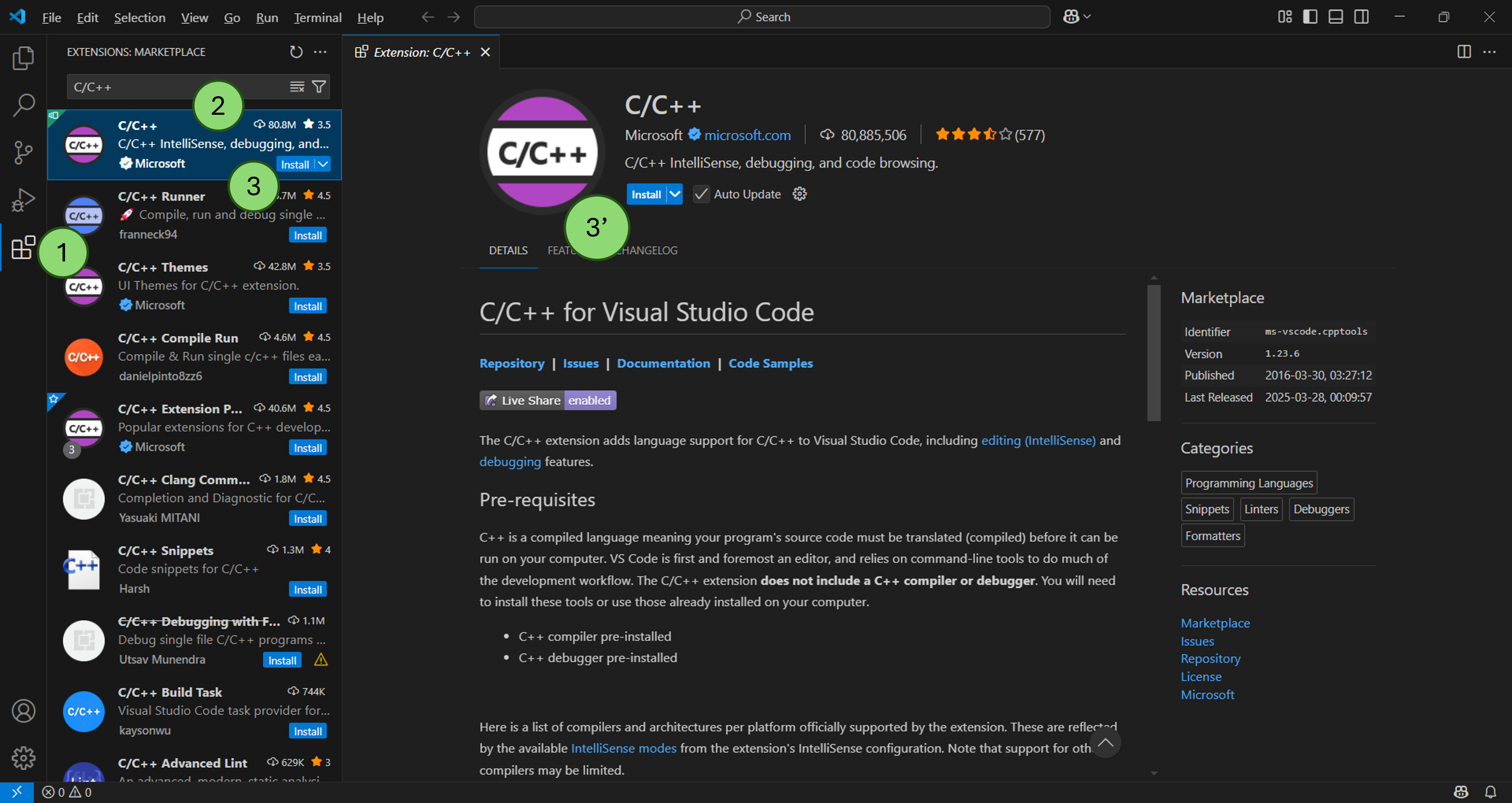
C/C++ extensions installation process¶
REMARK:
The figure shows the C/C++ extension, not the complete extension pack. Do not forget to also install CMake Tools.
CMake Tools - Configuration¶
The CMake Tools extension relies on two ways to configure CMake (i.e., 2 ways to provide information about your system’s compiler to CMake):
through CMake Presets,
through CMake Kits/Variants.
As using CMake presets is the recommended way for configuring CMake
Tools according to the reference tutorial (accessible
here), the
following tutorial will only consider this option. To avoid any
confusion, we strongly advise you to set the CMake Tools extension
options cmake.useCMakePresets to “always” and
cmake.enableAutomaticKitScan to “false”. These options (as all
other options) can be changed either:
by using the VS code settings UI,
or through the JSON setting file.
The VS code user settings UI can be triggered either through the command
palette (Ctrl + Shift + P) and selecting the “Preferences: Open
Setting (UI)” command or by clicking on the gear symbol next to the
extension on the “Extension” panel.
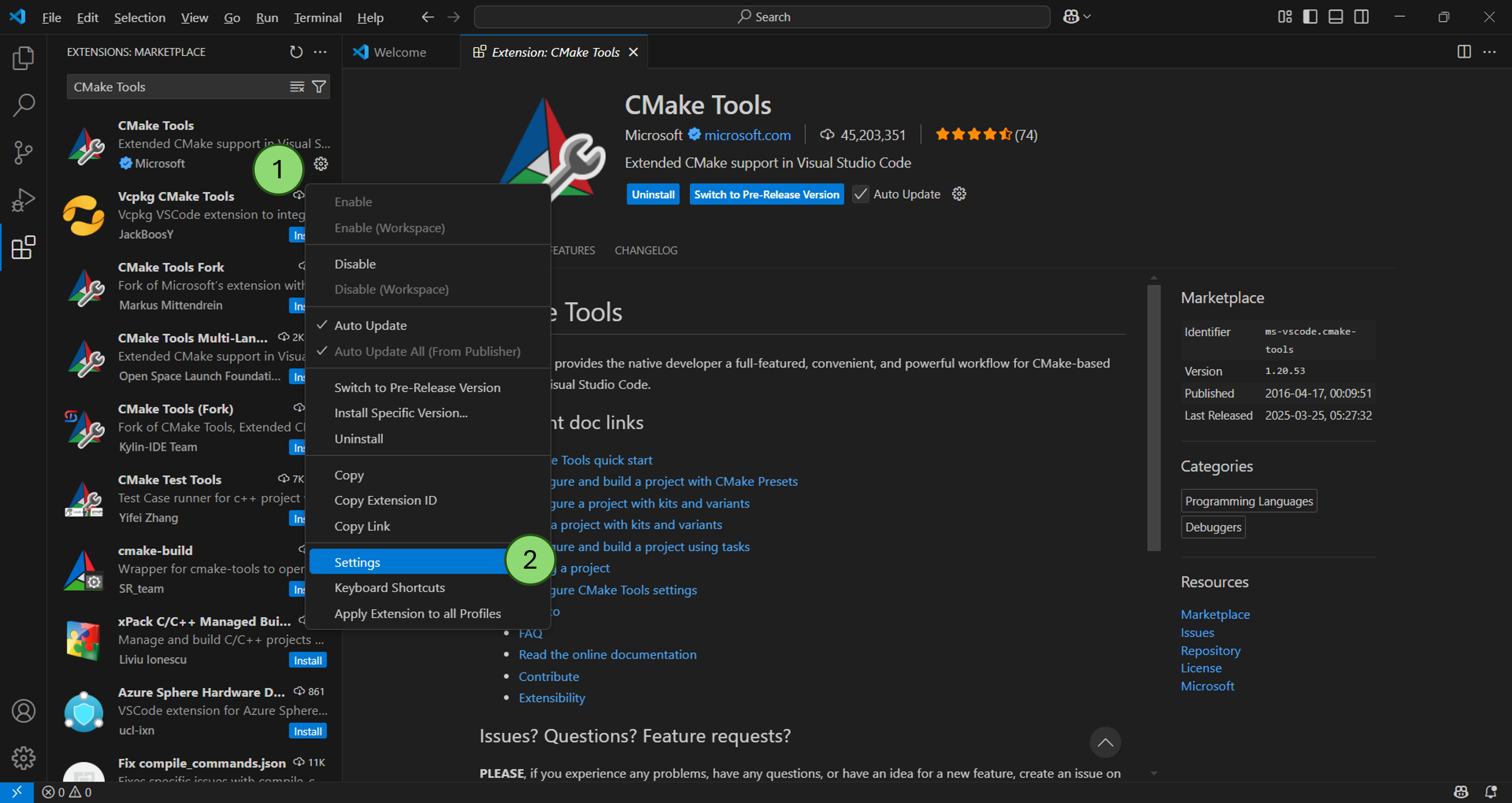
CMake Tools extensions settings¶
The JSON settings file can be opened by using the command palette
(Ctrl + Shift + P) and selecting the “Preferences: Open User
Settings (JSON)”.
We also recommend to set the options cmake.configureOnEdit and
cmake.configureOnOpen to “false” to avoid uncontrolled
configuration of your project by the extension.
Finally, Robotran projects have a common structure (see Folder
structure).
Therefore, we also recommend to set the default path to the
${sourceDirectory} to both "${workspaceFolder}/" and
"${workspaceFolder}/workR". This can be done in the JSON’s VS code
configuration file by adding the following setting:
"cmake.sourceDirectory": [
"${workspaceFolder}/",
"${workspaceFolder}/workR/"
],
REMARK:
If you experience switching issues between the two paths of the
cmake.sourceDirectoryarray, go check the ‘tips & tricks’ section, here.
CMakePreset - How to? for Robotran projects¶
By using CMake Tools extension, the user will not have to manually use
the command cmakeand cmake --build to configure and generate
their solution. Those commands will be called by VS code using buttons.
Yet, the use of buttons does not allow to provide options to CMake
during the configuration and generation steps. To bypass this
limitation, we recommand to use CMake
Presets.
CMake Presets are JSON files (named CMakePresets.json or
CMakeUserPresets.json) used to provide configuration settings to build
projects. They are a functionality of CMake and used by VS code through
the command flag --preset <preset_name> given to the cmake
and/or cmake --build (done automatically by CMake Tools extension,
so transparent for the VS code user). They can be automatically
generated by CMake Tools using the command “CMake: Add Configure Preset”
through the VS code command palette (notice that this functionality is
automaticaly triggered when opening a project where no CMakePreset.json
was found). Using the option:
“Custom”: it will generate a “CMakePreset.json” file in your
${sourceDirectory}(generic path variable used by CMake Tools extension to define the path where the CMakeList.txt file of your project must be stored) folder containing the required fields pre-filled with default values;“Create from compiler”: it will scan your computer to find the usable compiler. Once you have selected the dedicated compiler, CMake Tools extension will generate the CMakePreset.json file with the required compiler information.
“Toolchain File”: NOT CONSIDERED IN THIS TUTORIAL.
In a CMake Presets file we find at least two main fields:
The
versionfields: A required integer representing the version of the JSON schema.The
configurePresetsfields: An optional array of Configure Preset objects. This is allowed in preset files specifying version 1 or above.
In the configurePresets fields you will enter all the options
required for the project configuration. If an option is not mentioned
CMake will automatically detect the value to use. CMake variables such
as CMAKE_BUILD_TYPE, CMAKE_INSTALL_PREFIX and
CMAKE_PREFIX_PATH can be modified in the cacheVariables field
itself contained in the configurePresetsfield.
REMARKS:
Since version 1.26 of MBsysC, the user needs to define the installation path of MBsysC during MBsysC compilation through the option
-DCMAKE_INSTALL_PREFIX(see section “Compiling with developer power shell” of the MBsysC installation tutorial) and during Robotran project compilation through the option-DCMAKE_PREFIX_PATH(see section “Compiling in terminal Developer Command Prompt for Visual Studio (Windows)” of the Bodies and joints instruction). This shall be done in CMake presets through the optionsCMAKE_INSTALL_PREFIXandCMAKE_PREFIX_PATH).
The buildPresets can also be used to provide building objects mainly
useful for Multi-Config generator such as Visual Studio generators. If
you use a Single-Config generator (such as MakeFile on Linux), we advise
you not the add the build preset field (expect if you know what you are
doing) and to use the default option of CMake during the building
process.
// TODO: Add a CMakePresets.json example here. Use the code insertion canevas.
TIPS:
Visual Studio generators and Ninja Multi-Config can generate multiple configurations (Debug, Release, …) at once with
CMAKE_CONFIGURATION_TYPESinstead of only one configuration withCMAKE_BUILD_TYPE. Therefore, by design the configuration to build must be defined through the building options (and not by theCMAKE_BUILD_TYPEoptions for the configuration). This can be achieved by specifying theconfigurationoptions in thebuildPresetsassociated with the dedicated configure preset (this is done by setting the configure preset name in theconfigurePresetoptions).
Build preset field contained in the CMakePreset.json¶
Compiler - Installation¶
On Windows, you have three options for selecting your compiler:
Use the classical MSVC compiler from Microsoft;
Install Mingw-w64 to use GCC and GDB on Windows;
Use the Windows subsystem for Linux (WSL2) that allows you to access a Linux distribution (such as Ubuntu) directly on Windows.
Microsoft Visual C++ (MSVC) compiler
If you have a recent version of Visual Studio, open the Visual Studio Installer from the Windows Start menu and verify that the C++ workload is checked. If it’s not installed, then check the box and select the Modify button in the installer.
You can also install the Desktop development with C++ workload without a full Visual Studio IDE installation. From the Visual Studio Downloads page, scroll down until you see Tools for Visual Studio under the All Downloads section and select the download for Build Tools for Visual Studio 2022.
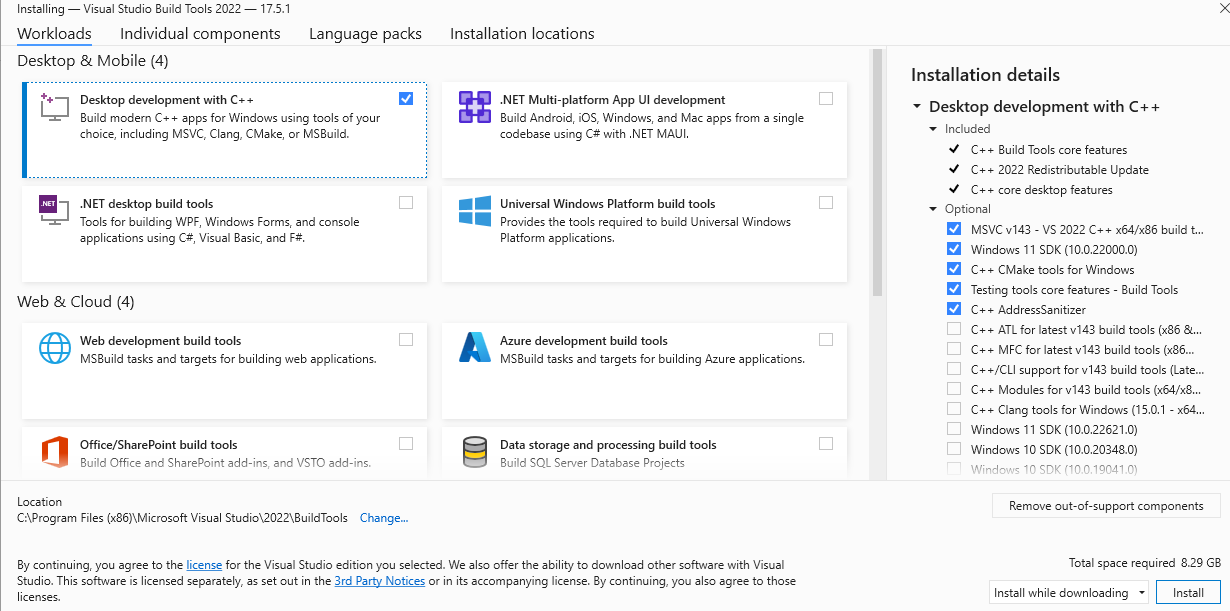
Download MSVC from Visual Studio installer¶
You can verify that you have correctly installed MSVC by opening the
Developer Command Prompt for Visual Studio from the Windows start
menu and type cl.exe. If MSVC is correctly installed on your
computer, you should obtain an output similar to the following
screen-shot.

Output of the cl.exe command¶
GCC and GDB on Windows through MinGW
As recommended in the Visual Studio Code official tutorial, we recommend to install the MinGW-w64 via MSYS2 which provides up-to-date native builds of GCC, MinGW-w64, and other helpful C++ tools and libraries for Windows.
Start by downloading MSYS2 latest installer from their website.
Run the installer and follow the steps of the installation wizard. Note that MSYS2 requires 64 bit Windows 8.1 or newer.
In the wizard, choose your desired Installation Folder. Record this directory for later. In most cases, the recommended directory is acceptable. The same applies when you get to setting the start menu shortcuts step. When complete, ensure the Run MSYS2 now box is checked and select Finish. This will open a MSYS2 terminal window for you.
In this terminal, install the MinGW-w64 toolchain by running the following command:
pacman -S --needed base-devel mingw-w64-ucrt-x86_64-toolchain
Accept the default number of packages in the
toolchaingroup by pressingEnter.
Enter
Ywhen prompted whether to proceed with the installation.Add the path of your MinGW-w64
binfolder to the WindowsPATHenvironment variable.
Once all these steps are done, check your MinGW installation by opening a new Command Prompt and type:
gcc -v
gdb -v
g++ -v
If information about which version of GCC, GDB and g++ is installed on your machine, is displayed in the prompt then the installation process is finished. If it is not the case:
Make sure your PATH variable entry matches the MinGW-w64 binary location where the toolchain was installed.
If gcc has the correct output but not gdb, then you need to install the packages you are missing from the MinGW-w64 toolset.
If on compilation you are getting the “The value of miDebuggerPath is invalid.” message, one cause can be you are missing the mingw-w64-gdb package.
Access Ubuntu through WSL
Visual Studio Code has support for working directly in WSL with the WSL extension. We recommend this mode of WSL development, where all your source code files, in addition to the compiler, are hosted on the Linux distro. For more background, see VS Code Remote Development.
First make sure you have correctly installed Windows Subsystem for Linux and the distribution of your choice (we recommend Ubuntu).
Second, even though, you will use VS Code to edit the source code, it will be compiled on Linux using GNU compiler collection (GCC, GDB and g++). You must then install it on your WSL distro. From the WSL command prompt, start by running the following command from the WSL terminal to update the Ubuntu package lists. An out-of-date Linux distribution can sometimes interfere with attempts to install new packages.
sudo apt update
Next install the GNU compiler tools and the GDB debugger with this command:
sudo apt install build-essential
Verify that the installation process was successful by displaying gcc, gdb and g++ version:
gcc -v
gdb -v
g++ -v
It shall display information about which version of GCC, GDB and g++ is installed on your machine.
Once WSL distro is installed, Visual Studio Code can be used to open
a project using the code command in WSL terminal with the path to
your project.
code <path/to/your/project>
TIPS:
Using the
.path as option to thecodecommand, i.e.:code .will open VS Code in the current working folder, which becomes your “workspace”.
You can verify that the project is well open from the WSL extension
of VS code if [WSL: YourDistro] is displayed next to your project
name (see following figure where Ubuntu 22.04 distro was used).

Verify WSL extension¶
When working on WSL, make sure that all the required VS code extensions (e.g., C/C++, CMake, …) are installed and enabled on your WSL instance.
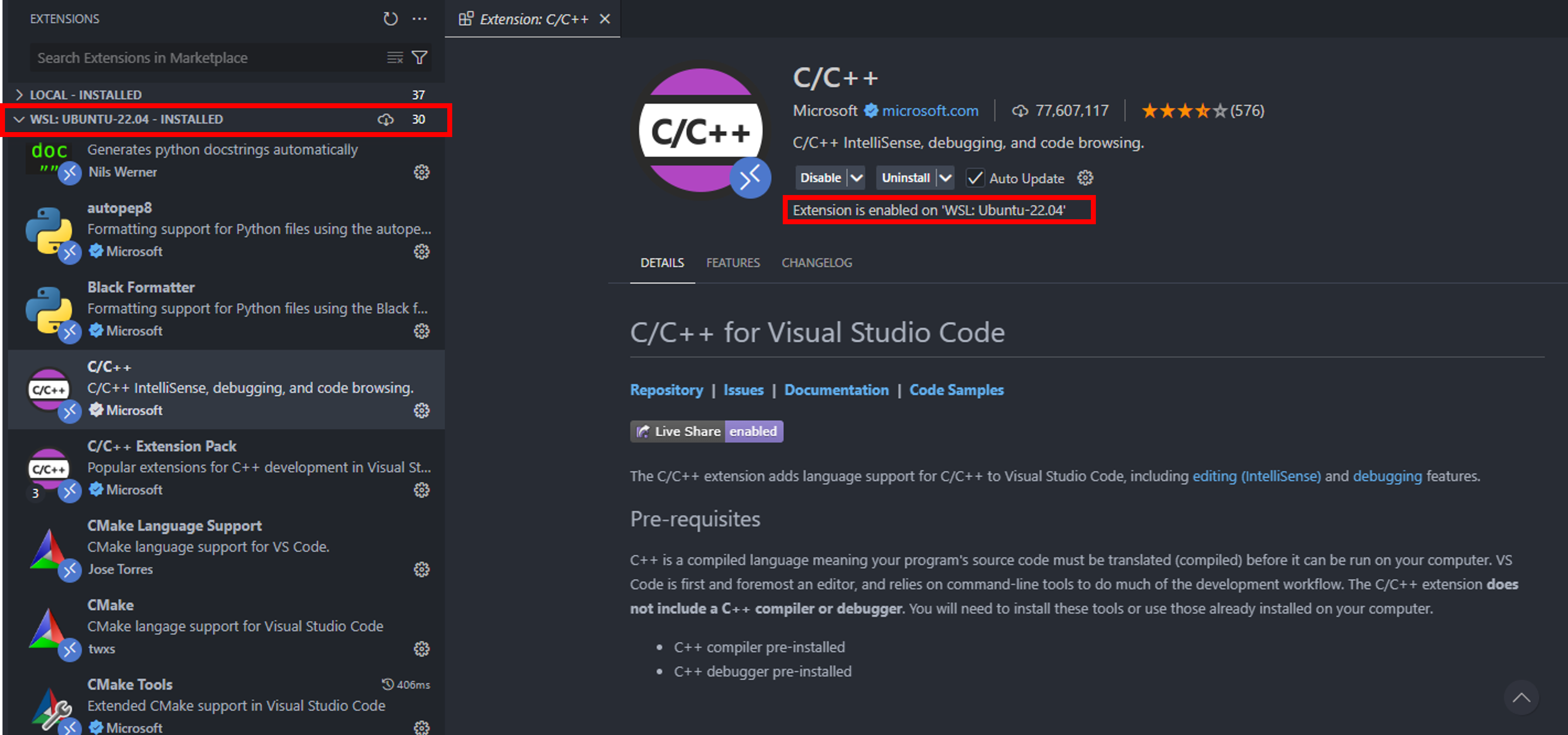
VS code extension enabled on WSL¶
Day-to-day usage¶
Using VS code, multiple options are possibles to open your Robotran project as your VS code workspace:
with the “open folder” option in VS code (File->Open Folder …)
using the
codecommand in a terminal consoleas already mentionedabove:
code <path/to/your/project>
Through the code command option, the path to your project can be
absolute or relative from the current directory of your terminal
session.
When you need to compile your project, you can use the CMake Tools extension to configure and build your project.
First make sure that the CMake Tools extension selected the correct
active folder as its ${sourceDirectory} (if it is not the case,
check this solution). If CMake Tools
finds the CMakePreset.json file and displays the CMake Tools extension
icon in the left panel then it has selected the correct folder.
CMake Tools extension icon¶
If the extension icon is not displayed then either the CMakePreset.json
file does not exist yet or the active folder of the CMake Tools
extension is not the correct one. The active folder selected by CMake
Tools can be changed through the command palette (Ctrl + Shift + P)
and selecting the “CMake: Select Active Folder” command.
A CMakePreset.json file can be created thanks to the CMake Tools
extension by using the command palette (Ctrl + Shift + P) and
selecting the “CMake: Add Configure Preset” command (as already
explained above).
WARNING:
The CMakePreset.json file must be created in the same folder as the CMakeList.txt file of your project.
Then, when the correct CMakePreset.json file is selected, and after configuring the CMake preset (see section CMakePreset - How to for Robotran projects?), you can configure and build your project by using:
The CMake Tools extension icon in the left panel of VS code (1) and selecting the “Configure” (2) or “Build” (3) option from the menu. The configure and build preset can be selected by clicking on the pen displayed next to the current preset name.
CMake Tools extension icon¶
the command palette (
Ctrl + Shift + P) and selecting the “CMake: Configure” (or “CMake: Build”) command. The configure and build preset can be selected upstream by using the command “CMake: Select Configure Preset” or “CMake: Select Build Preset” respectively.
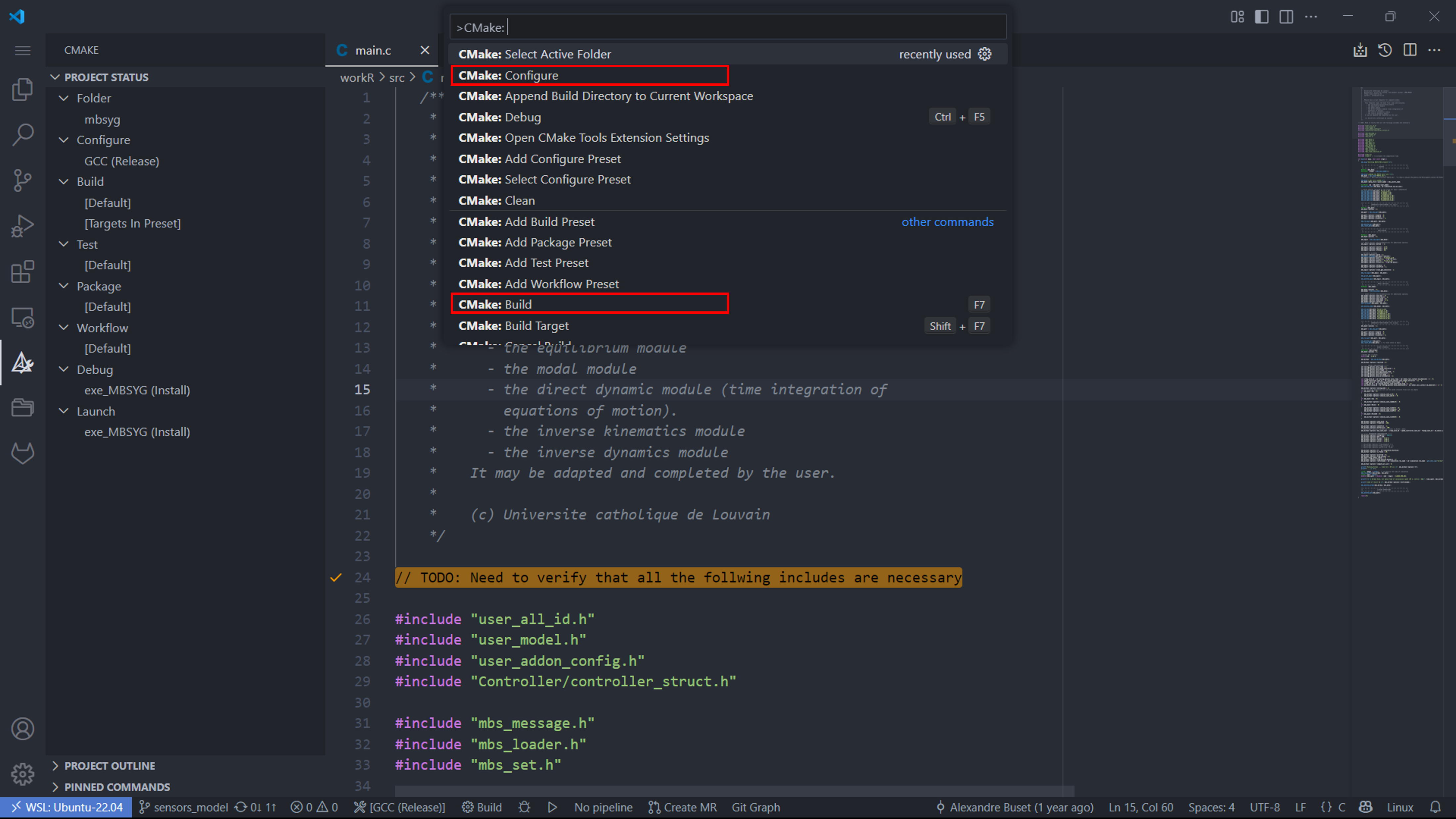 ,
,
the CMake Tools extension buttons in the status bar of VS code (if their visibility was activated as described in the following article).
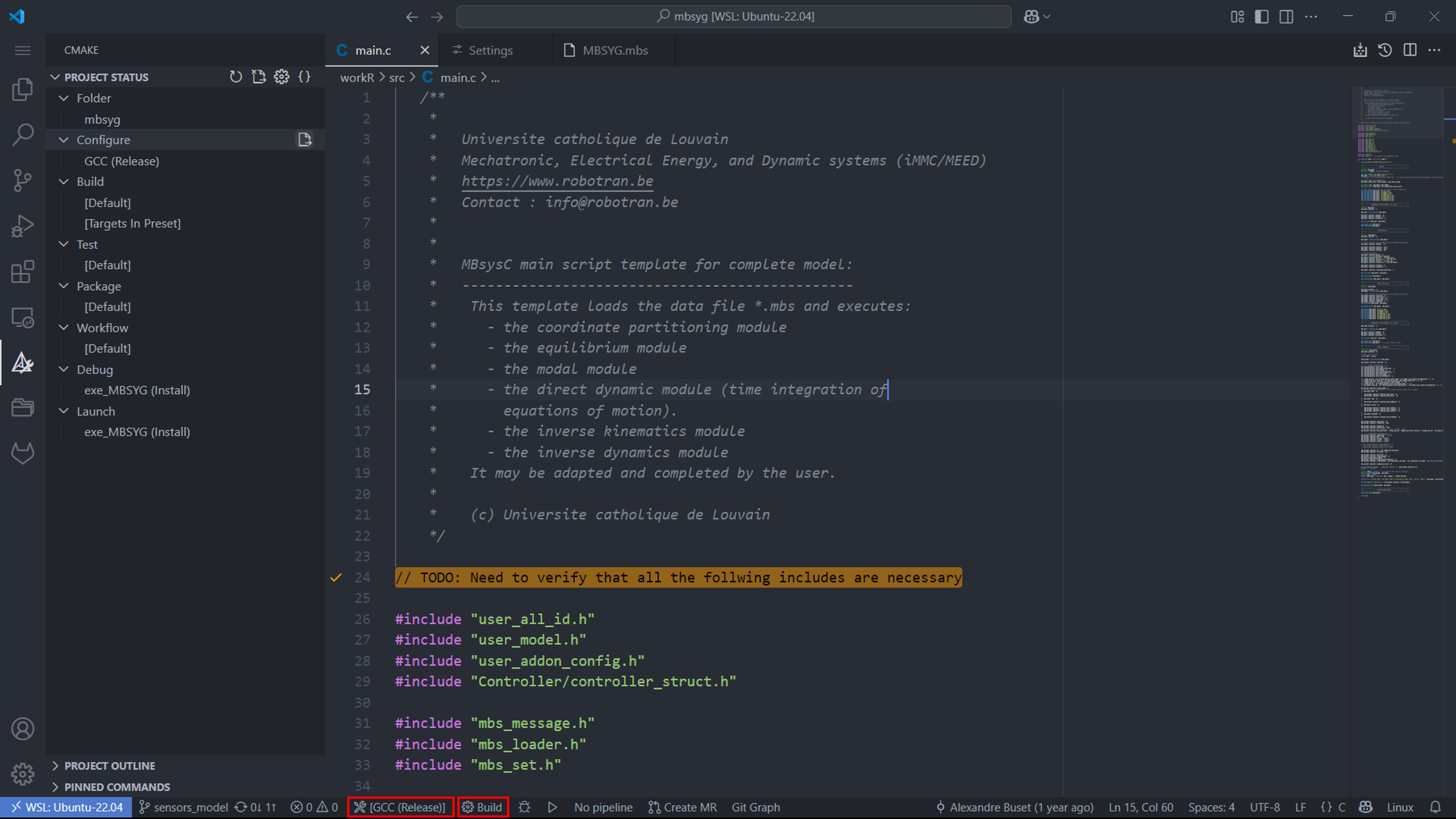
CMake Tools extension buttons in the status bar¶
Once the project solution is correctly build, you can run the simulation in debug or launch by using either the buttons from the CMake Tools extension tab on the left panel (1) and (2) or the buttons in the status bar (3) and (4) if their visility was activated.
Tips & tricks¶
Force cmake.sourceDirectory¶
If you experience any issue related to the cmake.sourceDirectory
selection in your workspace: e.g., the selected source directory
switches back to the first value of the cmake.sourceDirectory array
defined in the CMake tool settings (it can show up as CMake not finding
your CMakelists file for example). You can force the path of the source
directory for your current project using the VS Code workspace settings.
To do so, edit the ${workspace}/.vscode/settings.json file. Open it
either by:
opening it directly from your file explorer or terminal;
using the VS Code command palette and executing the command “Preferences: Open Workspace Settings (JSON)”.
This file controls all the VS Code options specific to your current project (it overwrites the global VS Code and user settings). Add the line:
"cmake.sourceDirectory": "path/to/your/source_directory",
You can of course use substitution variables such as
${workspaceFolder} which holds the path of the folder you opened in
VS Code. In robotran projects your source_directory is the workR folder,
so if you opened the main folder of the project with VS Code you will
set the variable to :
"cmake.sourceDirectory": "${workspaceFolder}/workR",